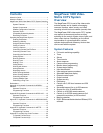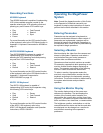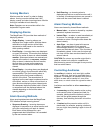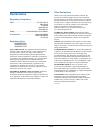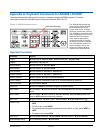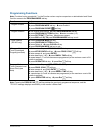
MEGAPOWER CPU 8200-0421-02, REV. E
OPERATOR’S GUIDE
7 of 21
Arming Monitors
Monitors must be “armed” in order to display
alarms. Arming a monitor defines how it will
display, queue, and clear incoming alarms. Monitor
Arming is available at local sites only.
Note: Operators can arm monitors while in the
keyboard’s Program mode.
Displaying Alarms
The MegaPower CPU provides three methods of
displaying alarms:
• Single Display – incoming alarms are
displayed on a single monitor. Multiple alarms
received at a single monitor will be either
sequenced or held based on the monitor’s
alarm queuing method.
• Dual Display – incoming alarms are displayed
on a pair of monitors. The monitor that receives
the first of a series of alarms is called the hold
monitor. Subsequent alarms are received and
queued at the second, or sequence, monitor.
After an alarm is cleared on the hold monitor,
the first alarm in queue on the sequence
monitor is moved to the hold monitor until
cleared.
• Block Display – incoming alarms are displayed
on a block (group) of monitors with which they
are associated. The first incoming alarm is
displayed on the first (lowest numbered)
monitor of the block. The second alarm is
displayed on the next lowest numbered monitor
of the block, and so on. When all monitors in a
given block are displaying alarm video signals,
all subsequent alarms are either held in queue
or sequenced until the displayed alarms are
cleared depending on the monitor alarm
queuing method.
Alarm Queuing Methods
Alarm queuing determines how the MegaPower
CPU handles multiple incoming alarms:
• Sequence Queuing – incoming alarms are
displayed in sequence at an armed monitor and
will cycle continuously until each is cleared.
Each alarm will be displayed for a pre-
programmed dwell time before it is succeeded
by the next received alarm.
• Hold Queuing – an incoming alarm is
displayed and held on an armed monitor until it
is cleared. All subsequent alarms are queued in
order until the current held alarm is cleared.
Alarm Clearing Methods
Alarms are cleared by three different methods:
• Manual clear – an alarm is cleared by a system
operator’s keyboard command.
• Instant Clear – an alarm is reset immediately at
its source. For example, a door opens and
activates an alarm. Closing the door clears the
alarm instantly.
• Auto Clear – an alarm is reset at its source
after a 20-second delay (if not manually
acknowledged sooner). For example, a door
opens and activates an alarm. Then, the door is
immediately closed. In this case, the alarm will
not clear until the door remains closed for a 20-
second interval.
CAUTION: Do not arm any monitor output that is
used as a video trunk output to a satellite site.
Monitor arming cannot be changed for any monitor
that has active alarms.
Controlling Auxiliaries
An auxiliary is a device, such as a light, audible
alarm, or door lock, that can be controlled from a
keyboard. For example, an operator could turn on
a light in a room with a camera in it, turn off an
alarm siren, or unlock a door for a guard to enter a
room.
Auxiliaries are classified as either momentary or
latched.
• A momentary auxiliary remains active as long
as its control button is pressed and held; for
example, holding down the button to unlock a
door until the guard passes through the
doorway, then releasing the button to lock the
door.
• A latched auxiliary remains active until it is
deactivated; for example, pressing a button to
turn on a light, then pressing it again to turn off
the light.






